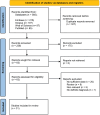Rituximab in the Treatment of Epidermolysis Bullosa Acquisita: A Systematic Review
- PMID: 39006807
- PMCID: PMC11238708
Rituximab in the Treatment of Epidermolysis Bullosa Acquisita: A Systematic Review
Abstract
Objective: Epidermolysis bullosa acquisita (EBA) is a rare dermatosis of the mucous membrane and/or skin. Employing biologic treatment modalities, specifically rituximab (RTX), have become pivotal measure in treating patients with blistering diseases. This study aims to summarize the current evidence on the safety and efficacy of RTX in EBA.
Methods: An extensive search was performed in MEDLINE/PubMed, Embase, Scopus, and Web of Science databases until the end of August 19th, 2023. Two independent reviewers screened the papers, and collected data. Two hundred thirty-three studies were screened using Preferred Reporting Items for Systematic Reviews and Meta-analyses guidelines.
Results: Thirty-one studies were enrolled. The most common reason of RTX administration in patients with EBA was recalcitrant diseases. Clinical response and disease remission was recorded as 92.7 percent (63 patients) and 73.8 percent (45 patients) of the patients, respectively. A relapse rate of 39.5 percent (15 patients) in the mean follow-up of 23.0 months was reported in the studies. Of the patients, 28.2 percent (11 patients) experienced RTX-related side events, mostly mild and transient infusion reactions.
Conclusion: The results of this systematic review demonstrated that RTX is safe and effective in patients with EBA. This biological treatment modality can be routinely used in managing EBA.
Keywords: Autoimmune bullous disease; epidermolysis bullosa acquisita; intravenous immunoglobulin; rituximab; systematic review.
Copyright © 2024. Matrix Medical Communications. All rights reserved.
Conflict of interest statement
DISCLOSURES: The authors report no conflicts of interest relevant to the content of this article.
Figures
Similar articles
-
Evaluation and Comparison of Clinical and iLaboratory Characteristics of Patients With IgA Epidermolysis Bullosa Acquisita, Linear IgA Bullous Dermatosis, and IgG Epidermolysis Bullosa Acquisita.JAMA Dermatol. 2021 Aug 1;157(8):917-923. doi: 10.1001/jamadermatol.2021.0762. JAMA Dermatol. 2021. PMID: 34160564 Free PMC article.
-
Rituximab in the Treatment of Epidermolysis Bullosa Acquisita: A Systematic Review of the Literature.J Drugs Dermatol. 2025 Apr 1;24(4):387-393. doi: 10.36849/JDD.8483. J Drugs Dermatol. 2025. PMID: 40196952
-
A Case Report of the Use of Rituximab and the Epidermolysis Bullosa Disease Activity Scoring Index (EBDASI) in a Patient with Epidermolysis Bullosa Acquisita with Extensive Esophageal Involvement.Acta Dermatovenerol Croat. 2018 Dec;26(4):325-328. Acta Dermatovenerol Croat. 2018. PMID: 30665483
-
Effectiveness and Safety of Rituximab in Recalcitrant Pemphigoid Diseases.Front Immunol. 2018 Feb 19;9:248. doi: 10.3389/fimmu.2018.00248. eCollection 2018. Front Immunol. 2018. PMID: 29520266 Free PMC article.
-
Case Report: Biological treatment of epidermolysis bullosa acquisita: report on four cases and literature review.Front Immunol. 2023 Jul 12;14:1214011. doi: 10.3389/fimmu.2023.1214011. eCollection 2023. Front Immunol. 2023. PMID: 37503352 Free PMC article. Review.
References
-
- Buijsrogge JJ, Diercks GF, Pas HH et al. The many faces of epidermolysis bullosa acquisita after serration pattern analysis by direct immunofluorescence microscopy. Br J Dermatol. 2011;165(1):92–98. - PubMed
Publication types
LinkOut - more resources
Full Text Sources

